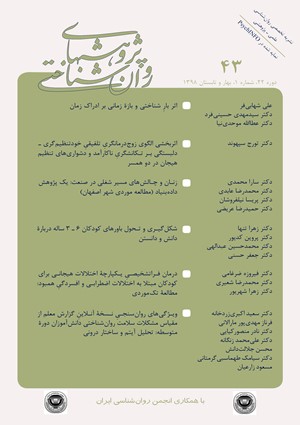اثربخشی الگوی زوج¬درمانگریِ تلفیقیِ خودتنظیم¬گری ـ دلبستگی بر تکانشگریِ ناکارآمد و دشواری¬های تنظیم هیجان در دو همسر
محورهای موضوعی :
1 - دانشگاه اراک
کلید واژه: زوج¬, درمانگری تلفیقیِ خود¬, تنظیم¬, گری ـ دلبستگیتکانشگریِ ناکارآمددشواریهای تنظیم هیجان زوج¬, ها,
چکیده مقاله :
پژوهش حاضر با هدف بررسی اثر بخشی الگوی زوج درمـانگریِ تلفیقـیِ خـودتنظیم گری ـ دلبستگی بر تکانشگریِ ناکارآمد و دشواری های تنظیم هیجان در زوج ها انجام شد. این مطالعه یک پژوهش نیمهآزمایشی دارای طــرح پيش-آزمـون ـ پس آزمون همـراه با گروه کنترل است. از بین زوج های مراجعه كننده به مراكز مشاورة شهرستان خرمآباد، تعداد 22 زوج انتخاب شدند و به گونة تصادفي، در گروه های آزمایش و کنترل، گمارده شدند. قبل از اجرای جلسات زوج درمانی، در پیش آزمون، مقیاس تکانشگری ناکارآمد (DIS) و مقیاس دشواری های تنظیم هیجان (DERS) در مورد تمامی زوج ها اجرا گردید. سپس زوج های گروه آزمایش در جلسات برنامة زوج درمانگری تلفیقیِ خودتنظیم گری ـ دلبستگی شرکت کردند، اما گروه کنترل، درمانی دریافت نکرد. بعد از اتمام جلسات درمانی، در پسآزمون، زوج های دو گروه مجدداً به همان مقیاس ها پاسخ دادند و داده های حاصل با استفاده از روش تحلیل کوواریانس چند متغیری(مانکووا) مورد تجزیه و تحلیل قرار گرفتند. نتایج نشان دادند که پس از کنترل اثرِ پیش آزمون، اثرِ عضویت گروه بر ترکیب خطی متغیرهای وابستة تکانشگریِ ناکارآمد و دشواری های تنظیم هیجان، معنادار بود. تحلیل کوواریانس تک متغیری نیز نشان داد که الگوی زوج-درمانگری تلفیقیِ خودتنظیم گری ـ دلبستگی در مقایسه با گروه کنترل، تأثیر معناداری بر کاهش تکانشگری ناکارآمد و دشواری های تنظیم هیجان گذاشته است (به جزء بر دشواریِ دست زدن به رفتار هدفمند). در نتیجه، زوج درمانگری تلفیقیِ خود تنظیم گری ـ دلبستگی به منزلة یک درمان مفید، می تواند در کاهش تکانشگریِ ناکارآمد و دشواری های تنظیم هیجان در زوج ها مؤثر باشد.
The present research has been conducted with the purpose of examining the efficacy of integrated model of self regulation-attachment couple therapy on dysfunctional impulsivity and difficulties in emotion regulation of couples. This study was a quasi-experimental research that had a pretest-posttest design with a control group. Among the couples referring to the councelling centers of Khoramabad city, 22 couples were selected and randomly assigned to experimental and control groups. Before performing couple therapy sessions, Dysfunctional Impulsivity Scale (DIS) and Difficulties in Emotion Regulation Scale (DERS) were conducted for all the couples as pretest. Then couples in the experimental group participated in integrated model of self regulation-attachment couple therapy, but the control group did not receive treatment. After completion of the therapeutic sessions, the couples of two the groups completed those scales again as the posttest. Finally, the data was analyzed by Multivariate Analysis of Covariance. The results indicated that after the control of pretest effect, the effect of group membership on linear composition of dependent variables of dysfunctional im-pulsivity and difficulties in emotion regulation was significant. Univariate Analysis of Covariance also indicated that self regulation-attachment couple therapy had significant efficacy on decreasing dysfunctional impulsivity and difficulties in emotion regulation (except on difficulties in engaging in goal-directed behavior), compared to the control group. In conclusion, integrated model of self- regulation-attachment couple therapy can be a useful and effective treatment in decreasing dysfunctional impulsivity and difficulties in emotion regulation of couples.


